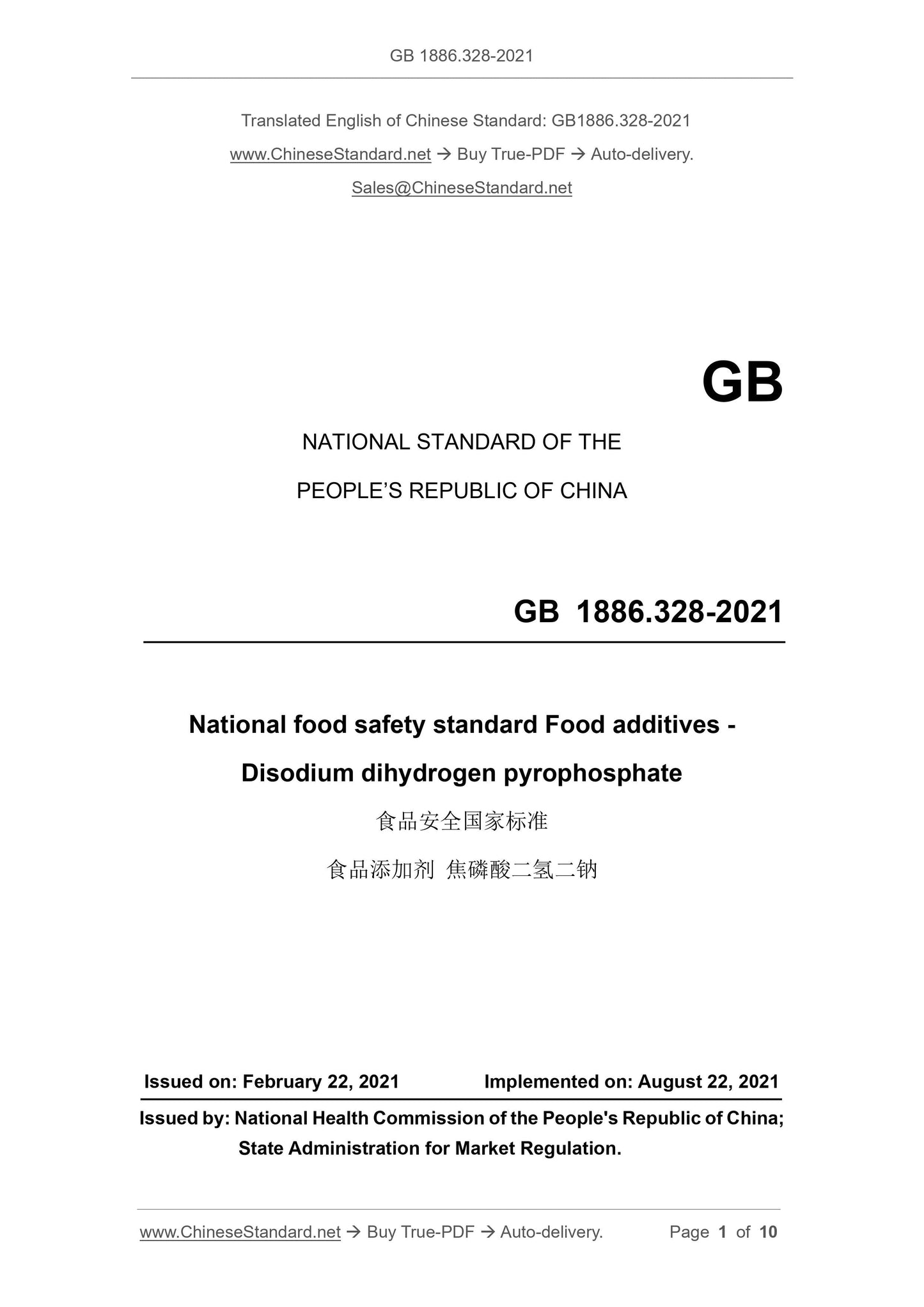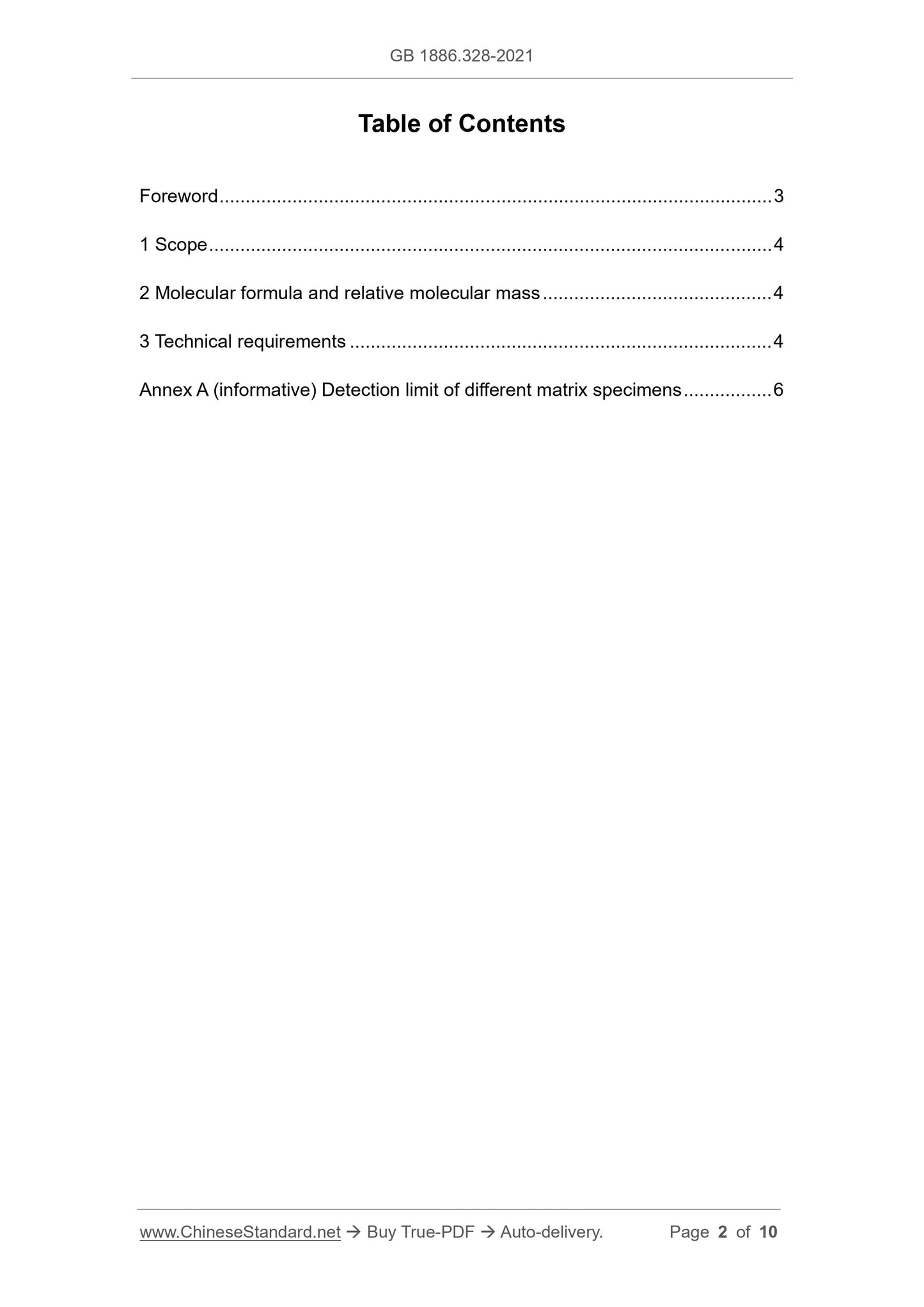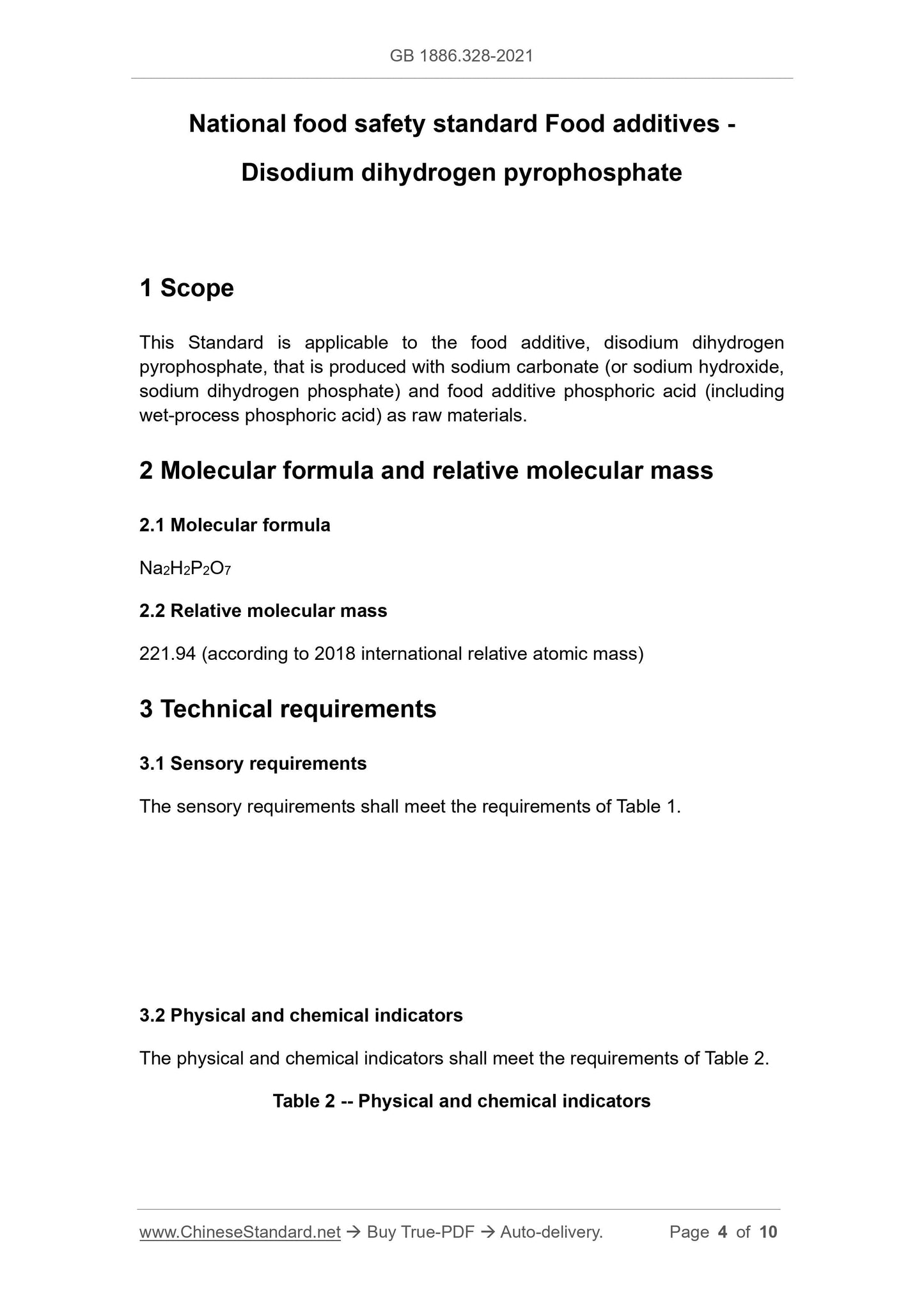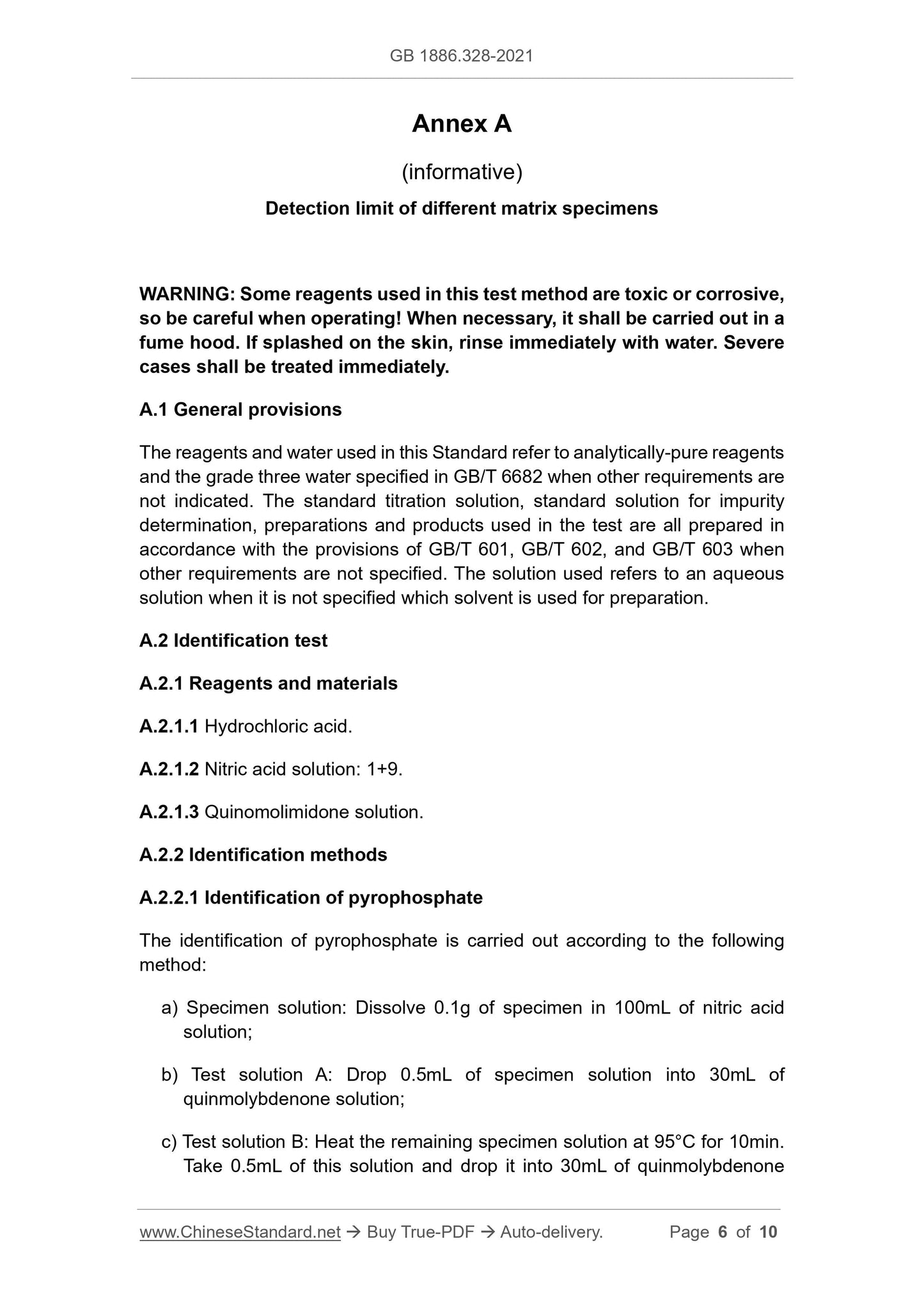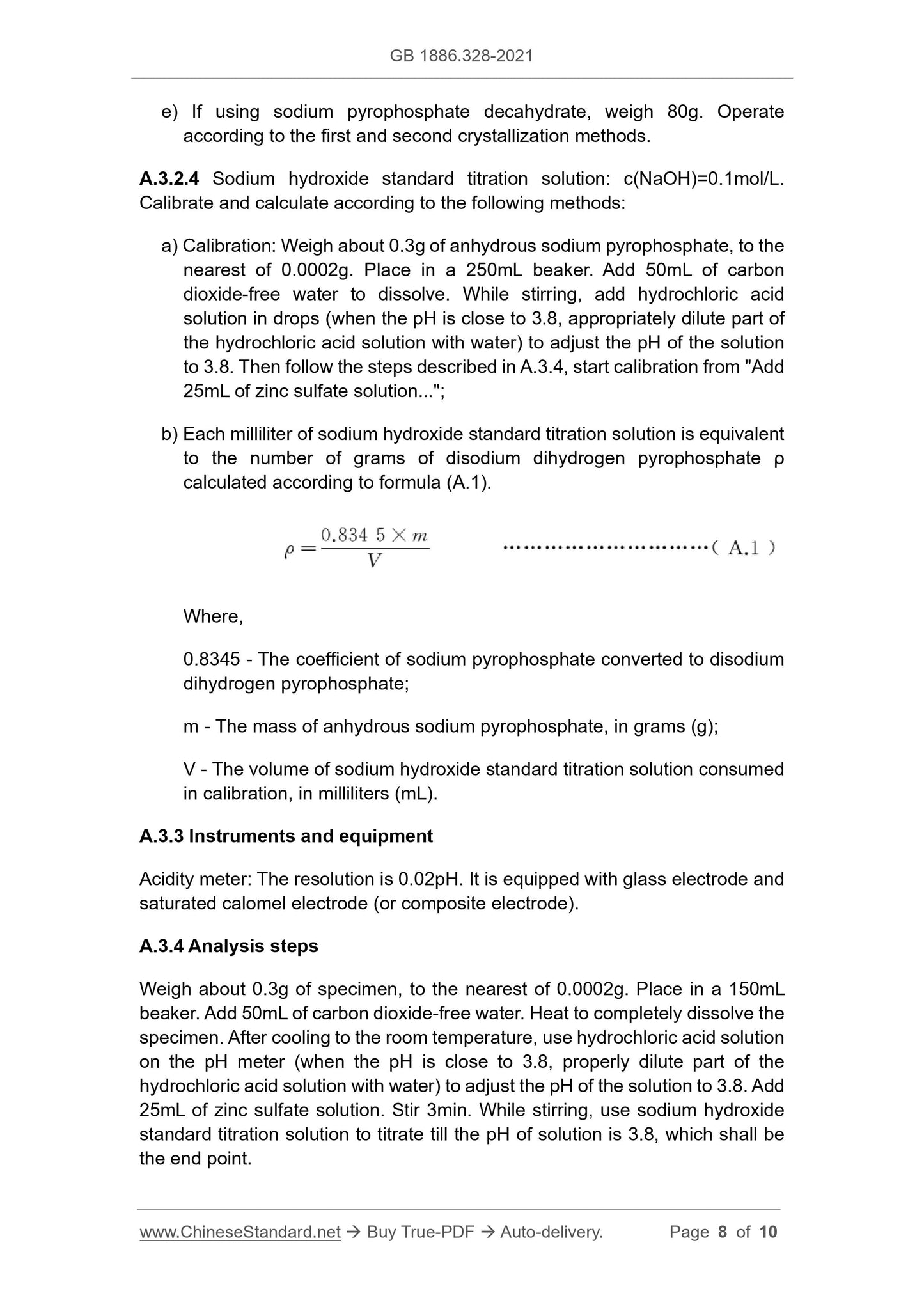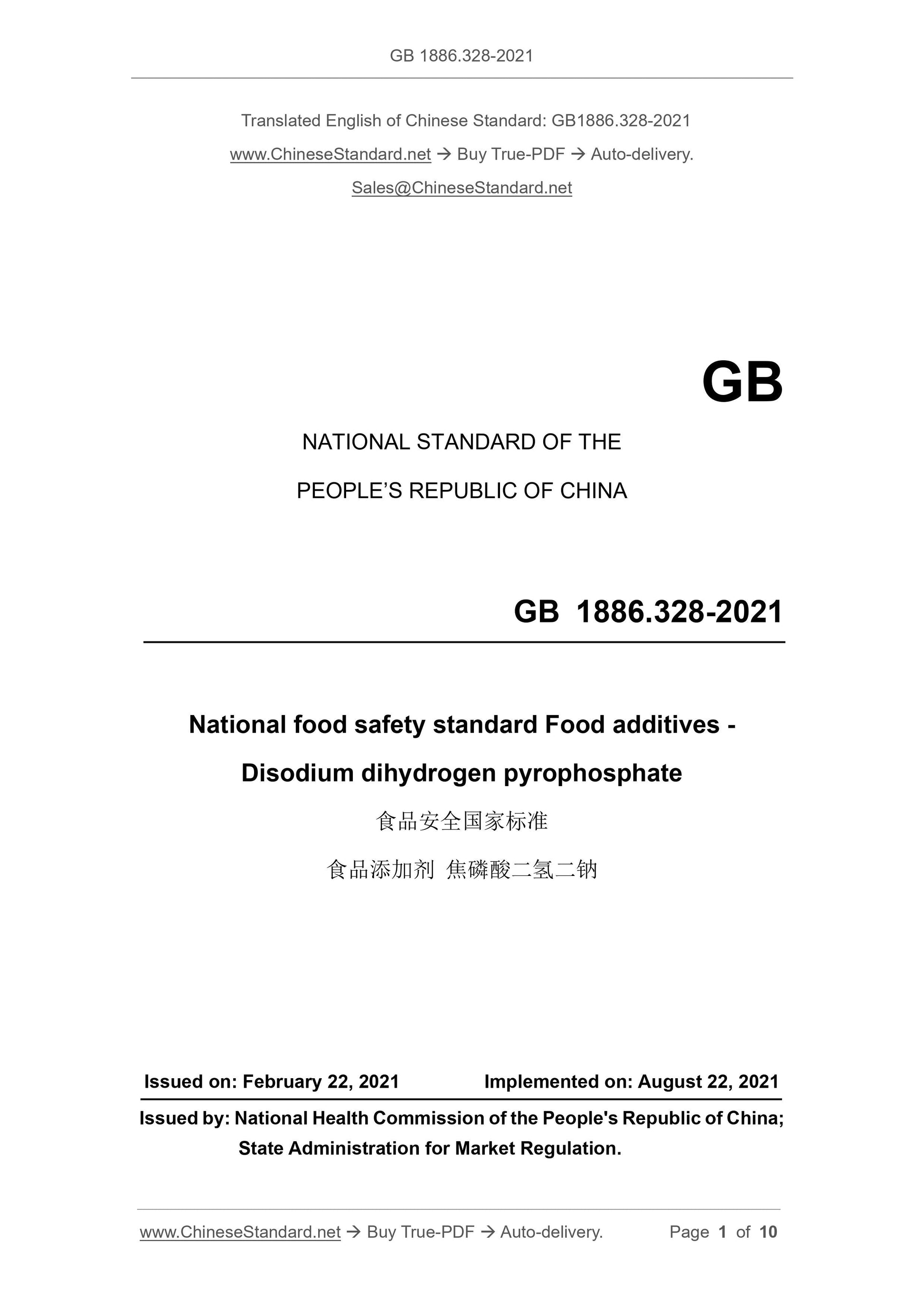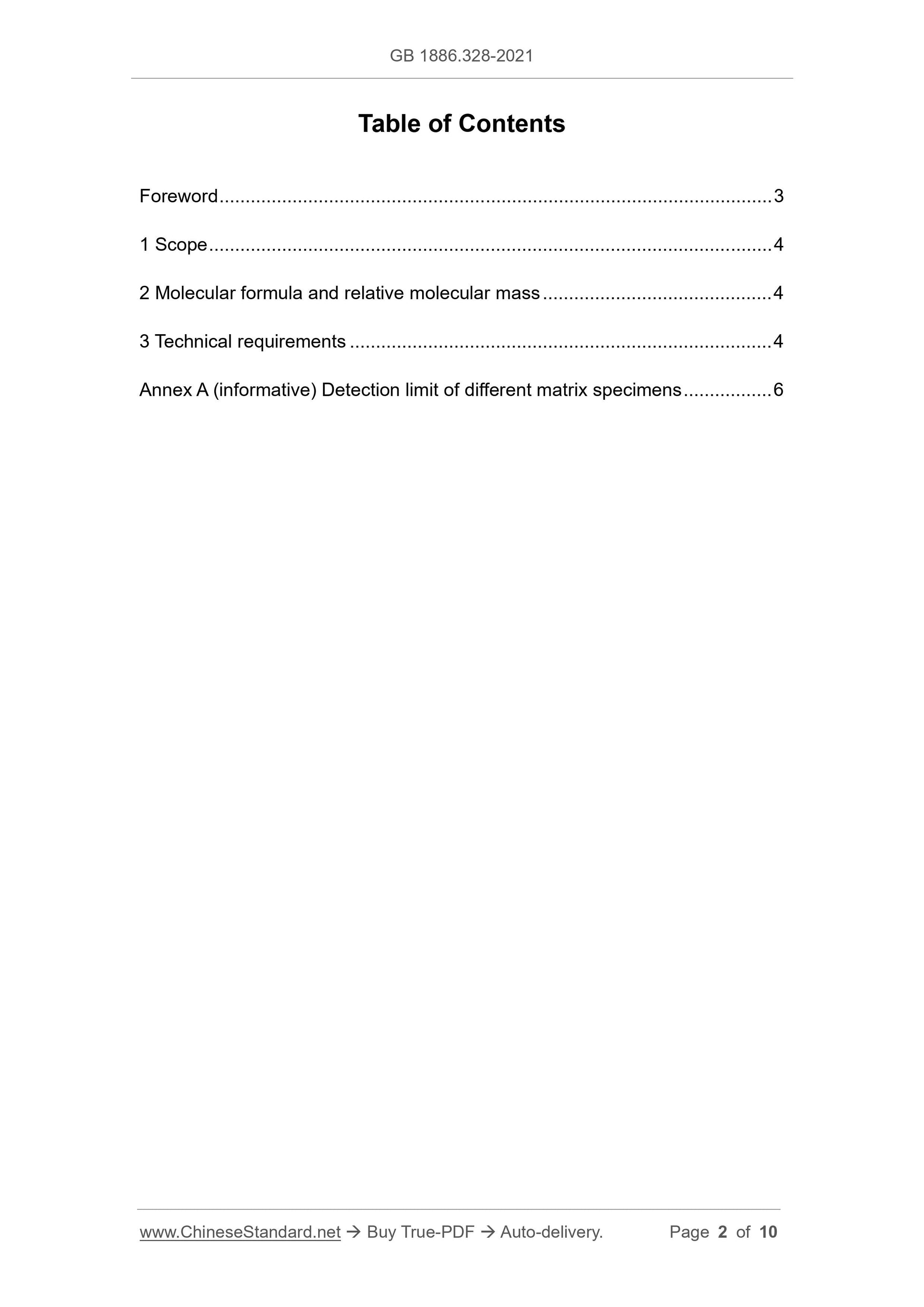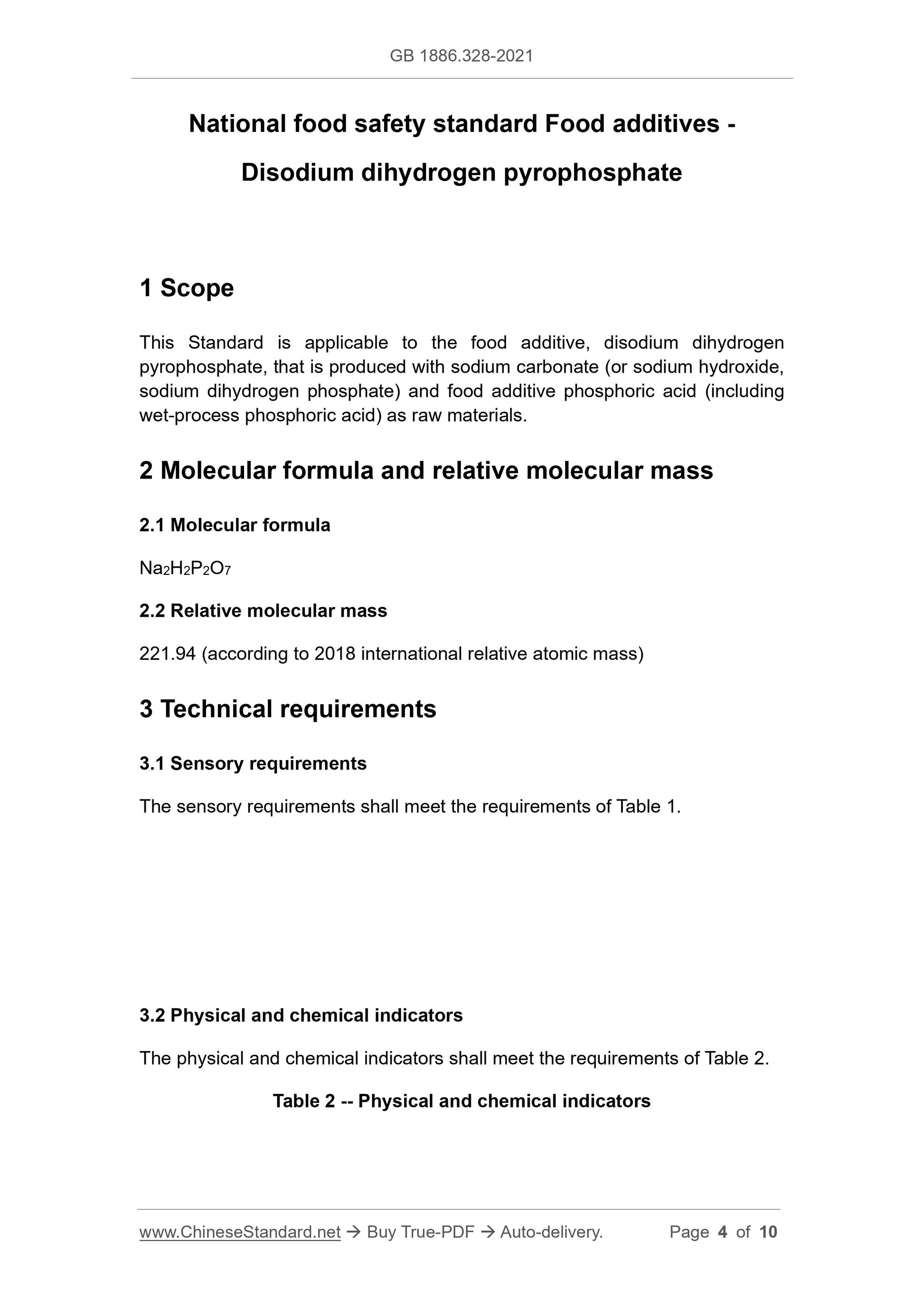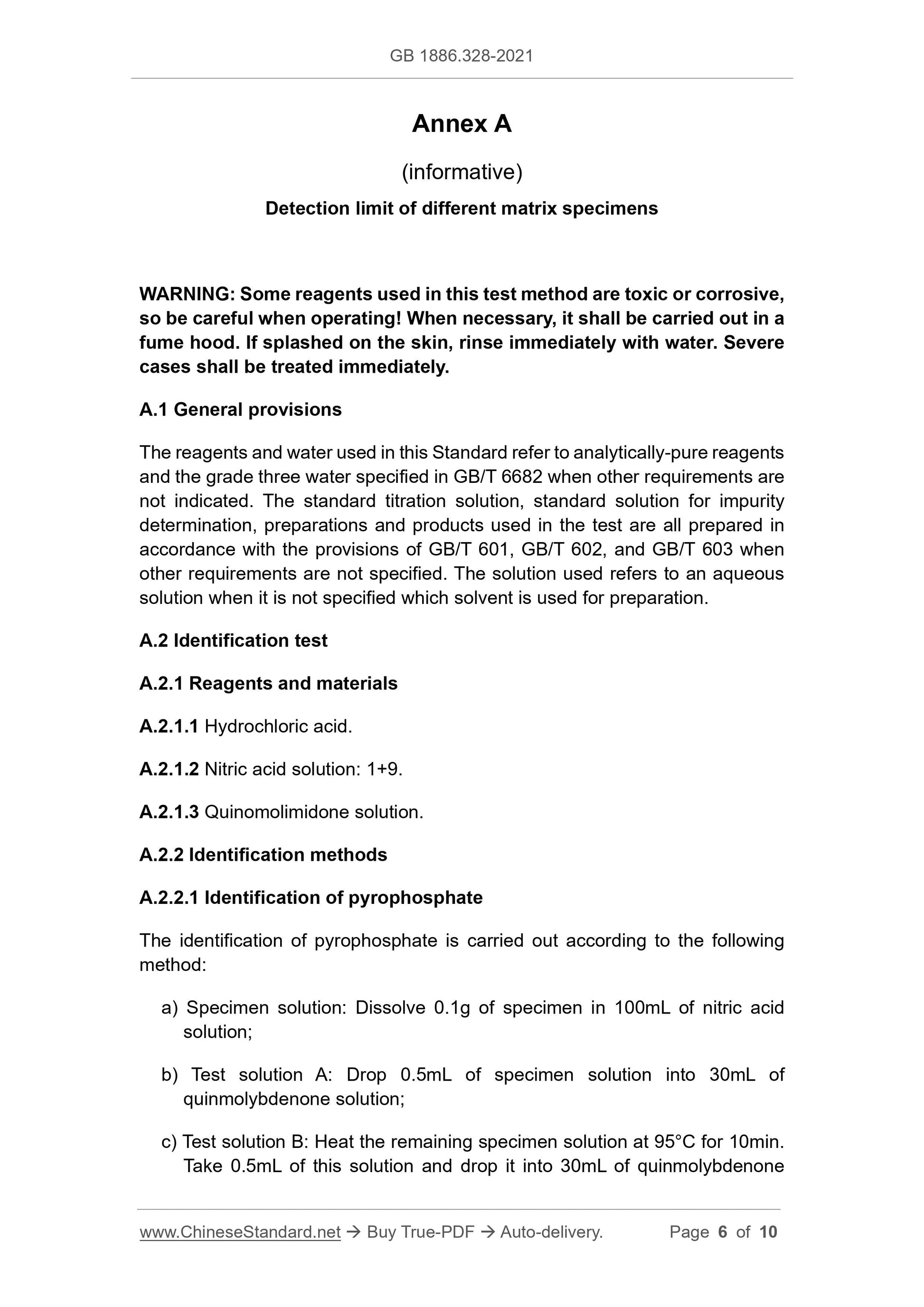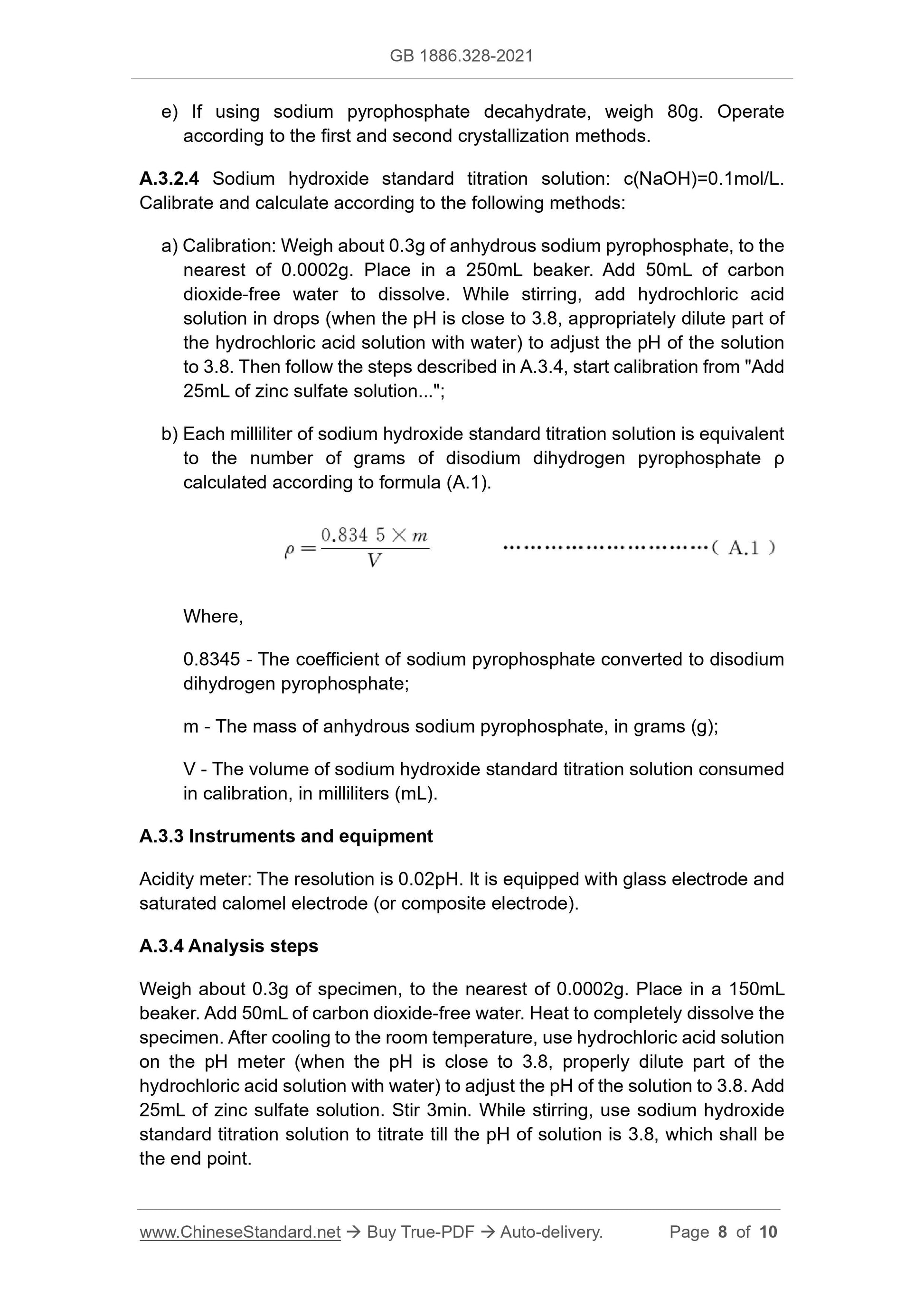1
/
of
5
PayPal, credit cards. Download editable-PDF & invoice in 1 second!
GB 1886.328-2021 English PDF (GB1886.328-2021)
GB 1886.328-2021 English PDF (GB1886.328-2021)
Regular price
$95.00 USD
Regular price
Sale price
$95.00 USD
Unit price
/
per
Shipping calculated at checkout.
Couldn't load pickup availability
Delivery: 3 seconds. Download true-PDF + Invoice.
Get QUOTATION in 1-minute: Click GB 1886.328-2021
Historical versions: GB 1886.328-2021
Preview True-PDF (Reload/Scroll if blank)
GB 1886.328-2021: National food safety standard - Food additives - Disodium dihydrogen pyrophosphate
GB 1886.328-2021
GB
NATIONAL STANDARD OF THE
PEOPLE’S REPUBLIC OF CHINA
National food safety standard Food additives -
Disodium dihydrogen pyrophosphate
食品添加剂 焦磷酸二氢二钠
ISSUED ON: FEBRUARY 22, 2021
IMPLEMENTED ON: AUGUST 22, 2021
Issued by: National Health Commission of the People's Republic of China;
State Administration for Market Regulation.
Table of Contents
Foreword ... 3
1 Scope ... 4
2 Molecular formula and relative molecular mass ... 4
3 Technical requirements ... 4
Annex A (informative) Detection limit of different matrix specimens ... 6
National food safety standard Food additives -
Disodium dihydrogen pyrophosphate
1 Scope
This Standard is applicable to the food additive, disodium dihydrogen
pyrophosphate, that is produced with sodium carbonate (or sodium hydroxide,
sodium dihydrogen phosphate) and food additive phosphoric acid (including
wet-process phosphoric acid) as raw materials.
2 Molecular formula and relative molecular mass
2.1 Molecular formula
Na2H2P2O7
2.2 Relative molecular mass
221.94 (according to 2018 international relative atomic mass)
3 Technical requirements
3.1 Sensory requirements
The sensory requirements shall meet the requirements of Table 1.
3.2 Physical and chemical indicators
The physical and chemical indicators shall meet the requirements of Table 2.
Table 2 -- Physical and chemical indicators
Annex A
(informative)
Detection limit of different matrix specimens
WARNING: Some reagents used in this test method are toxic or corrosive,
so be careful when operating! When necessary, it shall be carried out in a
fume hood. If splashed on the skin, rinse immediately with water. Severe
cases shall be treated immediately.
A.1 General provisions
The reagents and water used in this Standard refer to analytically-pure reagents
and the grade three water specified in GB/T 6682 when other requirements are
not indicated. The standard titration solution, standard solution for impurity
determination, preparations and products used in the test are all prepared in
accordance with the provisions of GB/T 601, GB/T 602, and GB/T 603 when
other requirements are not specified. The solution used refers to an aqueous
solution when it is not specified which solvent is used for preparation.
A.2 Identification test
A.2.1 Reagents and materials
A.2.1.1 Hydrochloric acid.
A.2.1.2 Nitric acid solution: 1+9.
A.2.1.3 Quinomolimidone solution.
A.2.2 Identification methods
A.2.2.1 Identification of pyrophosphate
The identification of pyrophosphate is carried out according to the following
method:
a) Specimen solution: Dissolve 0.1g of specimen in 100mL of nitric acid
solution;
b) Test solution A: Drop 0.5mL of specimen solution into 30mL of
quinmolybdenone solution;
c) Test solution B: Heat the remaining specimen solution at 95°C for 10min.
Take 0.5mL of this solution and drop it into 30mL of quinmolybdenone
e) If using sodium pyrophosphate decahydrate, weigh 80g. Operate
according to the first and second crystallization methods.
A.3.2.4 Sodium hydroxide standard titration solution: c(NaOH)=0.1mol/L.
Calibrate and calculate according to the following methods:
a) Calibration: Weigh about 0.3g of anhydrous sodium pyrophosphate, to the
nearest of 0.0002g. Place in a 250mL beaker. Add 50mL of carbon
dioxide-free water to dissolve. While stirring, add hydrochloric acid
solution in drops (when the pH is close to 3.8, appropriately dilute part of
the hydrochloric acid solution with water) to adjust the pH of the solution
to 3.8. Then follow the steps described in A.3.4, start calibration from "Add
25mL of zinc sulfate solution...";
b) Each milliliter of sodium hydroxide standard titration solution is equivalent
to the number of grams of disodium dihydrogen pyrophosphate ρ
calculated according to formula (A.1).
Where,
0.8345 - The coefficient of sodium pyrophosphate converted to disodium
dihydrogen pyrophosphate;
m - The mass of anhydrous sodium pyrophosphate, in grams (g);
V - The volume of sodium hydroxide standard titration solution consumed
in calibration, in milliliters (mL).
A.3.3 Instruments and equipment
Acidity meter: The resolution is 0.02pH. It is equipped with glass electrode and
saturated calomel electrode (or composite electrode).
A.3.4 Analysis steps
Weigh about 0.3g of specimen, to the nearest of 0.0002g. Place in a 150mL
beaker. Add 50mL of carbon dioxide-free water. Heat to completely dissolve the
specimen. After cooling to the room temperature, use hydrochloric acid solution
on the pH meter (when the pH is close to 3.8, properly dilute part of the
hydrochloric acid solution with water) to adjust the pH of the solution to 3.8. Add
25mL of zinc sulfate solution. Stir 3min. While stirring, use sodium hydroxide
standard titration solution to titrate till the pH of solution is 3.8, which shall be
the end point.
Get QUOTATION in 1-minute: Click GB 1886.328-2021
Historical versions: GB 1886.328-2021
Preview True-PDF (Reload/Scroll if blank)
GB 1886.328-2021: National food safety standard - Food additives - Disodium dihydrogen pyrophosphate
GB 1886.328-2021
GB
NATIONAL STANDARD OF THE
PEOPLE’S REPUBLIC OF CHINA
National food safety standard Food additives -
Disodium dihydrogen pyrophosphate
食品添加剂 焦磷酸二氢二钠
ISSUED ON: FEBRUARY 22, 2021
IMPLEMENTED ON: AUGUST 22, 2021
Issued by: National Health Commission of the People's Republic of China;
State Administration for Market Regulation.
Table of Contents
Foreword ... 3
1 Scope ... 4
2 Molecular formula and relative molecular mass ... 4
3 Technical requirements ... 4
Annex A (informative) Detection limit of different matrix specimens ... 6
National food safety standard Food additives -
Disodium dihydrogen pyrophosphate
1 Scope
This Standard is applicable to the food additive, disodium dihydrogen
pyrophosphate, that is produced with sodium carbonate (or sodium hydroxide,
sodium dihydrogen phosphate) and food additive phosphoric acid (including
wet-process phosphoric acid) as raw materials.
2 Molecular formula and relative molecular mass
2.1 Molecular formula
Na2H2P2O7
2.2 Relative molecular mass
221.94 (according to 2018 international relative atomic mass)
3 Technical requirements
3.1 Sensory requirements
The sensory requirements shall meet the requirements of Table 1.
3.2 Physical and chemical indicators
The physical and chemical indicators shall meet the requirements of Table 2.
Table 2 -- Physical and chemical indicators
Annex A
(informative)
Detection limit of different matrix specimens
WARNING: Some reagents used in this test method are toxic or corrosive,
so be careful when operating! When necessary, it shall be carried out in a
fume hood. If splashed on the skin, rinse immediately with water. Severe
cases shall be treated immediately.
A.1 General provisions
The reagents and water used in this Standard refer to analytically-pure reagents
and the grade three water specified in GB/T 6682 when other requirements are
not indicated. The standard titration solution, standard solution for impurity
determination, preparations and products used in the test are all prepared in
accordance with the provisions of GB/T 601, GB/T 602, and GB/T 603 when
other requirements are not specified. The solution used refers to an aqueous
solution when it is not specified which solvent is used for preparation.
A.2 Identification test
A.2.1 Reagents and materials
A.2.1.1 Hydrochloric acid.
A.2.1.2 Nitric acid solution: 1+9.
A.2.1.3 Quinomolimidone solution.
A.2.2 Identification methods
A.2.2.1 Identification of pyrophosphate
The identification of pyrophosphate is carried out according to the following
method:
a) Specimen solution: Dissolve 0.1g of specimen in 100mL of nitric acid
solution;
b) Test solution A: Drop 0.5mL of specimen solution into 30mL of
quinmolybdenone solution;
c) Test solution B: Heat the remaining specimen solution at 95°C for 10min.
Take 0.5mL of this solution and drop it into 30mL of quinmolybdenone
e) If using sodium pyrophosphate decahydrate, weigh 80g. Operate
according to the first and second crystallization methods.
A.3.2.4 Sodium hydroxide standard titration solution: c(NaOH)=0.1mol/L.
Calibrate and calculate according to the following methods:
a) Calibration: Weigh about 0.3g of anhydrous sodium pyrophosphate, to the
nearest of 0.0002g. Place in a 250mL beaker. Add 50mL of carbon
dioxide-free water to dissolve. While stirring, add hydrochloric acid
solution in drops (when the pH is close to 3.8, appropriately dilute part of
the hydrochloric acid solution with water) to adjust the pH of the solution
to 3.8. Then follow the steps described in A.3.4, start calibration from "Add
25mL of zinc sulfate solution...";
b) Each milliliter of sodium hydroxide standard titration solution is equivalent
to the number of grams of disodium dihydrogen pyrophosphate ρ
calculated according to formula (A.1).
Where,
0.8345 - The coefficient of sodium pyrophosphate converted to disodium
dihydrogen pyrophosphate;
m - The mass of anhydrous sodium pyrophosphate, in grams (g);
V - The volume of sodium hydroxide standard titration solution consumed
in calibration, in milliliters (mL).
A.3.3 Instruments and equipment
Acidity meter: The resolution is 0.02pH. It is equipped with glass electrode and
saturated calomel electrode (or composite electrode).
A.3.4 Analysis steps
Weigh about 0.3g of specimen, to the nearest of 0.0002g. Place in a 150mL
beaker. Add 50mL of carbon dioxide-free water. Heat to completely dissolve the
specimen. After cooling to the room temperature, use hydrochloric acid solution
on the pH meter (when the pH is close to 3.8, properly dilute part of the
hydrochloric acid solution with water) to adjust the pH of the solution to 3.8. Add
25mL of zinc sulfate solution. Stir 3min. While stirring, use sodium hydroxide
standard titration solution to titrate till the pH of solution is 3.8, which shall be
the end point.
Share
